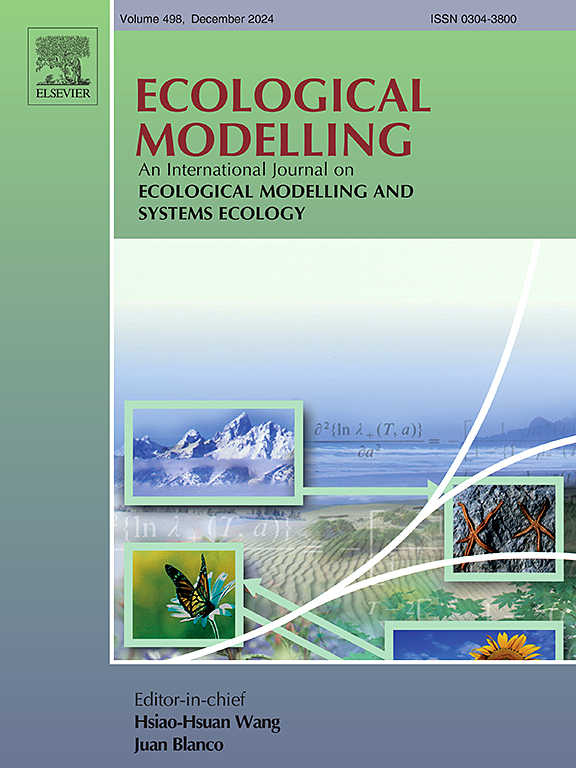Effects of temperature on asexual reproduction and jellyfish booms of Aurelia aurita: Insights from mathematical modeling
IF 2.6
3区 环境科学与生态学
Q2 ECOLOGY
引用次数: 0
Abstract
Elucidating the benthic stage growth and reproductive mechanisms of Aurelia aurita contributes to understanding irregular jellyfish blooms. This paper establishes a four-stage life history model of A. aurita (Polyp–Strobila–Ephyra–Medusa) to investigate the influence of seasonal temperature variations on the abundance of A. aurita. Sensitivity analyses indicate that jellyfish are most sensitive to bottom-up supplementation, with strobilation identified as an essential process in their life cycle. We explore the effects of parameters directly associated with strobilation in the Jiaozhou Bay area on population size, summarizing the interannual variations across the four stages of A. aurita, which aligns with empirical data. The investigation reveals that (i) consistent with recent biological literature, strobilation of A. aurita in temperate regions primarily occurs during periods of increasing spring sea surface temperatures rather than during autumn temperature declines, leading to summer jellyfish blooms; (ii) regression and subsequent strobilation favor an increase in the pelagic medusae population; (iii) the influence of rising sea surface temperatures due to climate change on the growth and reproduction of A. aurita manifests as initial stimulation followed by inhibition; (iv) earlier strobilation in spring may lead to more extensive A. aurita outbreaks in summer, providing insights for early warning of jellyfish blooms.
温度对 Aurelia aurita 无性繁殖和水母沸腾的影响:数学建模的启示
阐明 Aurelia aurita 底栖阶段的生长和繁殖机制有助于了解不规则水母水华。本文建立了 A. aurita(多孔体-Strobila-Ephyra-Medusa)的四阶段生命史模型,以研究季节性温度变化对 A. aurita 数量的影响。敏感性分析表明,水母对自下而上的补充最为敏感,而strobilation被认为是其生命周期中的一个重要过程。我们探讨了胶州湾海域与频变直接相关的参数对种群数量的影响,总结了海蜇四个阶段的年际变化,这与经验数据一致。调查发现:(i) 与最近的生物学文献一致,温带地区 A. aurita 的频变主要发生在春季海面温度上升期间,而不是秋季温度下降期间,这将导致夏季水母的大量繁殖;(ii) 回归和随后的频变有利于中上层介体种群的增加;(iii) 气候变化导致的海面温度上升对 A. aurita 生长和繁殖的影响表现为初始刺激和随后的频变。aurita 的影响表现为先刺激后抑制;(iv) 春季较早的频变可能会导致夏季 A. aurita 的大面积爆发,为水母水华的预警提供启示。
本文章由计算机程序翻译,如有差异,请以英文原文为准。
求助全文
约1分钟内获得全文
求助全文
来源期刊

Ecological Modelling
环境科学-生态学
CiteScore
5.60
自引率
6.50%
发文量
259
审稿时长
69 days
期刊介绍:
The journal is concerned with the use of mathematical models and systems analysis for the description of ecological processes and for the sustainable management of resources. Human activity and well-being are dependent on and integrated with the functioning of ecosystems and the services they provide. We aim to understand these basic ecosystem functions using mathematical and conceptual modelling, systems analysis, thermodynamics, computer simulations, and ecological theory. This leads to a preference for process-based models embedded in theory with explicit causative agents as opposed to strictly statistical or correlative descriptions. These modelling methods can be applied to a wide spectrum of issues ranging from basic ecology to human ecology to socio-ecological systems. The journal welcomes research articles, short communications, review articles, letters to the editor, book reviews, and other communications. The journal also supports the activities of the [International Society of Ecological Modelling (ISEM)](http://www.isemna.org/).
 求助内容:
求助内容: 应助结果提醒方式:
应助结果提醒方式:


